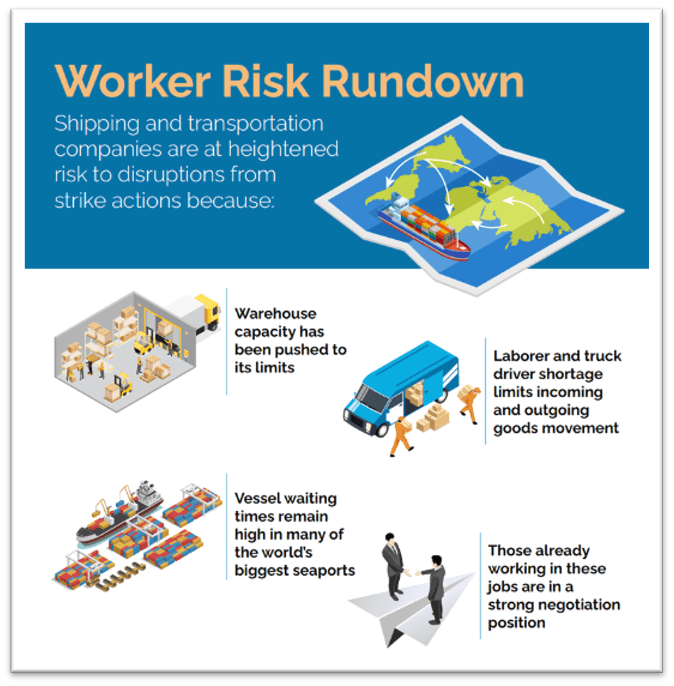Global labor issues and worker shortages predated the pandemic and Great Resignation, so don’t expect them to be resolved anytime soon. Strike actions continue rising in health care, logistics, food, and manufacturing sectors. Fluctuating regulations and high-exposure work environments are driving employees away from jobs. Shifting political structures influence worker availability.
Companies looking to navigate the shifting power balance between employers and workers will need visibility into future labor issues worldwide – not just for their own workforce, but for their suppliers and their suppliers.
Navigating an exodus of workers
Last year, the pandemic-inspired phrase “The Great Resignation” surfaced to describe workers, mainly in the U.S., quitting jobs at abnormally higher rates, leaving a record-breaking 10.9 million open jobs by the end of July 2021. The pandemic drove this labor shift, and COVID-related issues continue to hinder the return of a revived and reliable workforce.
As Omicron and potential subsequent variants linger, the risk of infection in the workplace remains. Companies are reassessing safety and worker compensation to avoid long-term disruptions due to industrial actions or outbreaks of disease.
Strengthening workplace safety regulations to mitigate risk creates another set of supply chain challenges.
Protesters fighting vaccine mandates recently blocked two-way traffic on Ambassador Bridge. As the busiest international land-border crossing in North America, it accommodates roughly 30% of the two-way annual trade between Canada and the U.S., which the latest U.S. data indicates was over $600 billion. Covid regulations and vaccine mandates by Canada and the U.S. on truckers have prompted workers to join demonstrations, creating further disruptions to the supply-chain network. This demonstration is inspiring a movement for copycat protests, as seen in Australia, New Zealand, and France, with more potentially on the way.
With the looming threat of more supply chain interruptions and delays, what risk factors should companies focus increased visibility on?

Forced labor concerns yield to due diligence
In addition to workforce labor disputes and pandemic fallout affecting business practices, emerging supply chain due diligence initiatives fighting against forced labor are poised to impact environmental and social labor assessments, reaching 2nd and 3rd tier suppliers for supply chain networks. This intercession in the forced labor crisis is occurring on a global scale.
A new U.S. law requires companies to provide proof that imported goods aren’t linked to forced labor in China, particularly in the Xinjiang region. Businesses across the tech, apparel, and energy sectors must now decipher whether their existing procedures will meet compliance requirements as a part of larger efforts to address human rights abuses.
Germany’s Supply Chain Due Diligence Act (enforced as of January 1, 2023) is designed to safeguard human rights and the environment in the global economy more effectively by obligating companies with 3000 or more employees in Germany to take “appropriate measures” to respect human rights within their supply chains.
This worldwide effort to increase transparency of business practices will drive an already growing need for digitalization as companies push for end-to-end visibility to integrate and comply with upcoming human and labor rights goals.
Resetting our risk mindset
In the wake of The Great Resignation, pandemic mandates, and human rights reparations, the balance of power appears to be shifting in favor of labor, placing more pressure on companies into the second half of the year.
Yet, with risk comes opportunity. Visibility into ongoing risk trends will differentiate businesses from their competitors.